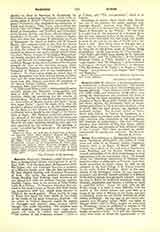

Baroccio (BAROCCI), FEDERIGO, called Fiore d’Urbino, a distinguished painter and engraver, b. at Urbino, 1528; d. at the same place, September 30, 1612. His father, who was Ambrogio Baroccio, a sculptor, of a Milanese family, gave him his first art lessons. He then studied drawing with Francesco Manzocchi of Forli. His uncle, the architect Bartolommeo Genga, deciding that Federigo must become an artist, placed him with the eminent Venetian painter, Battista Franco, then in the service of Duke Guidobaldo II at Urbino. On Franco’s departure Baroccio went to his uncle’s house at Pesaro, and while studying perspective with him, copied some pictures of Titian in the ducal gallery. When twenty he went to Rome and spent his time chiefly in the study of the works of his great townsman, Raphael. On his return to Urbino, Baroccio copied the pastels of Correggio, and painted some pictures which brought him much reputation. His subjects were chiefly religious, and included some large altar-pieces. Of these he etched two masterpieces, “The Pardon of San Francesco d’Assisi”, which is at Urbino, and “The Annunciation”, which is at Loretto.
Returning to Rome, where Guido della Revere was one of his patrons, the artist, together with Federigo Zuccaro, received from Pope Pius IV the commission to decorate the little palace of the Bosco di Belvedere in the Vatican. At this time it is said that he was poisoned at a banquet given him by some painters jealous of his success. From this he never recovered, for four years was unable to work at all, and for the rest of his life but a few hours a day. After three years at Perugia, and a short visit to Florence, Baroccio returned to end his long life of eighty-four years at Urbino, dying of apoplexy. In the Louvre are his “Circumcision“, “The Virgin and Child Jesus adored by St. Anthony and St. Lucy”, and “St. Catherine”; in the London National Gallery a “Holy Family“; at Urbino a “Last Supper” and “St. Sebastian”; at the cathedral in Perugia a “Descent from the Cross”; at Ravenna “The Martyrdom of St. Vitalis”; at Naples a “Holy Family“; and at Rome a “Last Supper” and “Christ and Magdalen”.

